

Quantum engineering pushes refrigerator beyond classical efficiency limits. (Phys.org) —The laws of thermodynamics determine what is possible and impossible in classical systems.

Lately, scientists have been working on establishing quantum analogues of these fundamental laws to determine the performance limits of quantum systems. Now in a new study, scientists have established the thermodynamic limits on quantum absorption refrigerators, and then somewhat counterintuitively show how quantum engineering techniques can push the refrigerators beyond these limits, resulting in superefficient cooling. World's First Entanglement-Enhanced Microscope. One of the exciting possibilities of quantum mechanics is the ability to measure the world far more precisely than with classical tools.
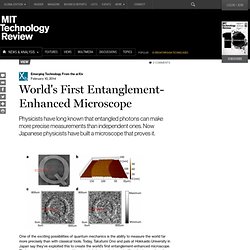
Today, Takafumi Ono and pals at Hokkaido University in Japan say they’ve exploited this to create the world’s first entanglement-enhanced microscope. Their new toy produces images with entangled photons that are significantly sharper than those possible with ordinary light alone. Entanglement is the strange quantum property in which two particles share the same existence, even though they may be far apart. Quantum dots provide complete control of photons: News: Research.
By emitting photons from a quantum dot at the top of a micropyramid, researchers at Linköping University are creating a polarized light source for such things as energy-saving computer screens and wiretap-proof communications.

Polarized light – where all the light waves oscillate on the same plane – forms the foundation for technology such as LCD displays in computers and TV sets, and advanced quantum encryption. Normally, this is created by normal unpolarized light passing through a filter that blocks the unwanted light waves. Unlocking nature's quantum engineering for efficient solar energy. (Phys.org)—Quantum scale photosynthesis in biological systems which inhabit extreme environments could hold key to new designs for solar energy and nanoscale devices.

Certain biological systems living in low light environments have unique protein structures for photosynthesis that use quantum dynamics to convert 100% of absorbed light into electrical charge, displaying astonishing efficiency that could lead to new understanding of renewable solar energy, suggests research published today in the journal Nature Physics.
The research resolves an important mystery in the newly-emerging field of quantum biology – the origins and longevity of the quantum, wave-like properties that transport energy during the early stages of photosynthesis, phenomena unexpectedly observed in molecular complexes extracted from a variety of plants, algae and bacteria. Explore further: A new key to unlocking the mysteries of physics? Quantum turbulence. Gravitational-wave finding causes 'spring cleaning' in physics. Detlev van Ravenswaay/Science Photo Library Artist's rendering of 'bubble universes' within a greater multiverse — an idea that some experts say was bolstered with this week's discovery of gravitational waves.

On 17 March, astronomer John Kovac of the Harvard-Smithsonian Center for Astrophysics presented long-awaited evidence of gravitational waves — ripples in the fabric of space — that originated from the Big Bang during a period of dramatic expansion known as inflation. By the time the Sun set that day in Cambridge, Massachusetts, the first paper detailing some of the discovery’s consequences had already been posted online1, by cosmologist David Marsh of the Perimeter Institute for Theoretical Physics in Waterloo, Canada, and his colleagues. Cosmologist Marc Kamionkowski of Johns Hopkins University in Baltimore, Maryland, agrees that some axion models no longer work, “because they require inflation to operate at a lower energy scale than the one indicated by BICEP2”.
Quantum world record smashed. 14-Nov-2013 [ Print | E-mail ] Share [ Close Window ] Contact: University of Oxford Press Officepress.office@admin.ox.ac.uk 44-186-528-3877University of Oxford A normally fragile quantum state has been shown to survive at room temperature for a world record 39 minutes, overcoming a key barrier towards building ultrafast quantum computers.

New Experiments to Pit Quantum Mechanics Against General Relativity. It starts like a textbook physics experiment, with a ball attached to a spring.
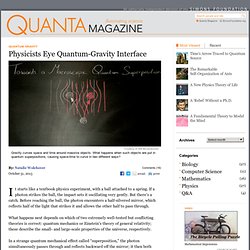
If a photon strikes the ball, the impact sets it oscillating very gently. But there’s a catch. Carver Mead's Spectator Interview. From American Spectator, Sep/Oct2001, Vol. 34 Issue 7, p68 Carver Mead The Spectator Interview Once upon a time, Nobel Laureate leader of the last great generation of physicists, threw down the gauntlet to anyone rash enough to doubt the fundamental weirdness, the quark-boson-muon-strewn amusement park landscape of late 20th-century quantum physics.
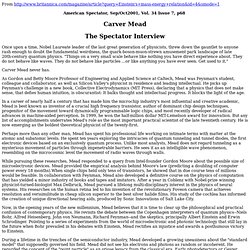
"Things on a very small scale behave like nothing you have direct experience about. Carver Mead never has. As Gordon and Betty Moore Professor of Engineering and Applied Science at Caltech, Mead was Feynman's student, colleague and collaborator, as well as Silicon Valley's physicist in residence and leading intellectual. Perhaps more than any other man, Mead has spent his professional life working on intimate terms with matter at the atomic and subatomic levels. While pursuing these researches, Mead responded to a query from Intel-founder Gordon Moore about the possible size of microelectronic devices. Among whom was Albert Einstein.
Who the fuck knows. Simple Explainations of Quantum Mechanics. Dark Matter. Speed of Light. Black Holes. Antimatter experiments present progress. At CERN today, representatives of the experiments that use beams from the Antiproton Decelerator presented their progress in 2012, and their plans for the New Year.
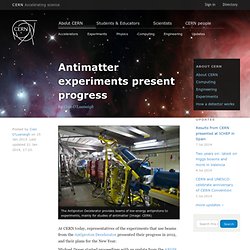
Michael Doser started proceedings with an update from the AEGIS experiment, which aims to measure the gravitational interaction between matter and antimatter. Doser described how in 2012 the AEGIS team tested their experimental setup using antiprotons and used other measurements to design an optimal layout for their experiment.
"Beam times were extremely valuable in understanding this new apparatus," says Doser. "In 2013 we hope to continue testing and commissioning with electrons and positrons, to commission a laser system for spectroscopy, and to install a positronium test station. " AEGIS aims to be ready to form an antihydrogen beam by summer 2014. Einstein's gravity theory passes toughest test yet: Bizarre binary star system pushes study of relativity to new limits. (Phys.org) —A strange stellar pair nearly 7,000 light-years from Earth has provided physicists with a unique cosmic laboratory for studying the nature of gravity.
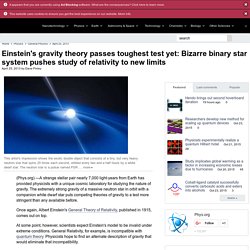
The extremely strong gravity of a massive neutron star in orbit with a companion white dwarf star puts competing theories of gravity to a test more stringent than any available before. Once again, Albert Einstein's General Theory of Relativity, published in 1915, comes out on top. At some point, however, scientists expect Einstein's model to be invalid under extreme conditions.
General Relativity, for example, is incompatible with quantum theory. Physicists hope to find an alternate description of gravity that would eliminate that incompatibility. University of Southampton. New mathematical model links space-time theories Ref: 13/96 30 May 2013 A ‘black string’ black hole phenomenon Researchers at the University of Southampton have taken a significant step in a project to unravel the secrets of the structure of our Universe.
Professor Kostas Skenderis , Chair in Mathematical Physics at the University, comments: “One of the main recent advances in theoretical physics is the holographic principle. Uncertainty revisited: Novel tradeoffs in quantum measurement. (Phys.org) —There is, so to speak, uncertainty about uncertainty – that is, over the interpretation of how Heisenberg's uncertainty principle describes the extent of disturbance to one observable when measuring another. More specifically, the confusion is between the fact that, as Heisenberg first intuited, the measurement of one observable on a quantum state necessarily disturbs another incompatible observable, and the fact that on the other hand the indeterminacy of the outcomes when either one or the other observable is measured is bounded.
Recently, Dr. The future of physics: Beyond the numbers.